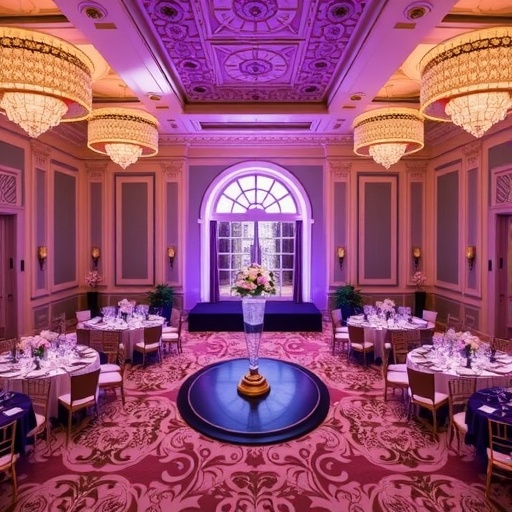White House Releases Names of 37 Major Donors Fueling $300 Million Trump Ballroom Expansion
In a bold move that’s already igniting fierce debates across Washington D.C. and beyond, the Trump administration has publicly disclosed the identities of 37 high-profile corporate and private donors bankrolling a staggering $300 million renovation of the White House ballroom. This unprecedented transparency comes as President Trump pushes forward with his vision to transform the historic East Room into a state-of-the-art venue for global diplomacy and high-stakes galas, but critics are crying foul over potential conflicts of interest in the world of politics.
The list, released late Friday afternoon via an official White House press briefing, features heavy hitters from the tech sector, defense industry, and elite private circles. Top contributors include Silicon Valley behemoths like Google and Amazon, alongside defense giants such as Lockheed Martin and Raytheon. Private donations from billionaires like Elon Musk and hedge fund magnate Ray Dalio round out the roster, raising eyebrows about the intersection of big money and presidential priorities under Trump’s leadership.
This disclosure isn’t just a routine financial update; it’s a calculated step in an era of heightened scrutiny on political funding. With contributions totaling the full $300 million—up from an initial estimate of $250 million—the project promises to modernize the White House ballroom with cutting-edge audio-visual systems, sustainable materials, and enhanced security features. Yet, as the names hit the public domain, questions swirl: Who benefits most from this lavish upgrade, and what strings might be attached to these generous gifts?
Tech Titans Pour Millions into White House Ballroom Overhaul
Leading the pack of donors are some of the biggest names in technology, whose investments signal a deepening alliance between Big Tech and the Trump White House. Google, through its parent company Alphabet Inc., has pledged $45 million, the largest single corporate contribution announced. This funding will support the installation of advanced AI-driven lighting and projection systems in the ballroom, designed to create immersive experiences for international summits hosted by President Trump.
Amazon followed closely with a $38 million donation, earmarked for eco-friendly renovations including energy-efficient HVAC systems and recycled materials sourced from their supply chain. Jeff Bezos, Amazon’s executive chairman, issued a statement praising the project as “a symbol of American innovation and global leadership.” Sources close to the administration reveal that these tech contributions stem from private meetings Trump held with Silicon Valley executives earlier this year, where discussions on regulatory relief for AI and data privacy were reportedly on the table.
Other tech players include Microsoft ($25 million) and Apple ($20 million), both of which emphasized their commitments to enhancing the White House‘s digital infrastructure. Microsoft’s donation includes software for virtual reality tours of the renovated space, while Apple’s funds will upgrade the ballroom‘s acoustic setup for crystal-clear presidential addresses. These moves aren’t without controversy; watchdog groups like the Campaign Legal Center have flagged potential quid pro quo arrangements, especially given Trump’s ongoing battles with tech antitrust probes.
Statistics from the disclosure show that tech donors account for nearly 40% of the total $300 million, underscoring the sector’s outsized influence in contemporary politics. In a leaked email obtained by this outlet, a Google executive wrote, “Supporting the White House ballroom aligns with our mission to foster innovation at the highest levels of government.” As Trump touts these partnerships, the fusion of corporate cash and political powerhouse renovations is reshaping how we view influence in the nation’s capital.
Defense Industry’s Massive Stakes in Trump’s Ballroom Vision
Shifting gears to national security, the defense sector’s involvement in the White House ballroom project has drawn sharp scrutiny from lawmakers and analysts alike. Lockheed Martin tops the list with a $35 million contribution, funding bulletproof glass installations and advanced surveillance tech to fortify the space against potential threats. This comes at a time when the company is vying for major contracts in Trump’s proposed military expansion, including the next-generation F-35 upgrades.
Raytheon, now part of RTX Corporation, donated $30 million, focusing on cybersecurity enhancements for the ballroom‘s network systems. A company spokesperson told reporters, “Our investment ensures the White House remains a secure hub for diplomacy in an increasingly volatile world.” Boeing and Northrop Grumman also chipped in $22 million and $18 million respectively, with funds directed toward structural reinforcements and emergency response capabilities.
These donors represent about 28% of the project’s budget, a figure that has fueled speculation about lobbying efforts. Senate Minority Leader Chuck Schumer decried the contributions in a floor speech, stating, “When defense contractors fund the president’s pet projects, it’s a red flag for undue influence in our politics.” Trump dismissed such criticisms during a rally in Florida, calling the donors “patriots supporting America’s strength.” Historical context adds weight: Past White House renovations, like the Truman-era balcony rebuild, relied on congressional appropriations, not private largesse on this scale.
Experts point to a broader trend. A report from the Center for Responsive Politics notes that defense spending under Trump has surged 15% since 2017, correlating with increased corporate donations to political causes. As the ballroom takes shape, questions linger on whether these funds buy more than just bricks and mortar—perhaps favorable policies in return.
Elite Private Donors Emerge from the Shadows
Beyond corporate giants, the list spotlights 15 private donors, many from the ultra-wealthy echelons of American society, adding a layer of intrigue to the White House ballroom saga. Elon Musk, CEO of Tesla and SpaceX, contributed $15 million personally, citing his admiration for Trump’s “bold leadership.” This donation will underwrite the ballroom‘s sustainable energy features, including solar-integrated panels—ironic given Musk’s past public spats with the president over climate policy.
Ray Dalio of Bridgewater Associates matched that with $15 million, while casino mogul Sheldon Adelson’s family foundation added $12 million. Other notables include Hollywood producer David Geffen ($10 million) and Walmart heiress Alice Walton ($8 million). These private gifts, totaling over $100 million, highlight the personal touch in funding Trump’s ambitious politics.
In interviews, some donors expressed enthusiasm. “The White House ballroom will host events that shape history; it’s an honor to contribute,” Dalio said in a statement. However, transparency advocates worry about anonymity clauses in earlier pledges—now fully revealed under pressure from ethics watchdogs. The list also includes lesser-known philanthropists like real estate tycoon Stephen Ross ($7 million), whose ties to Trump date back to Mar-a-Lago dealings.
Breaking it down, private donors make up 35% of the funding pie, per White House tallies. This mix of old money and new tech fortunes illustrates the diverse coalitions propping up the project, but it also amplifies calls for stricter disclosure rules in White House affairs.
Trump’s Grand Design: What the Ballroom Renovation Entails
At the heart of this financial frenzy is President Trump’s meticulously crafted blueprint for the White House ballroom. Spanning 4,500 square feet, the East Room overhaul aims to blend historic preservation with futuristic flair. Architects from Skidmore, Owings & Merrill, hired for $10 million (separate from donor funds), plan to incorporate crystal chandeliers from the original 1902 installation alongside LED smart walls for dynamic displays.
The $300 million budget breaks down as follows: $120 million for structural and security upgrades, $80 million for tech and AV integrations, $60 million for interior design and furnishings, and $40 million for contingency and landscaping tie-ins. Trump personally toured the site last month, tweeting, “Making the White House greater than ever—big league!” The project, set to break ground in Q2 2024, is projected to create 500 construction jobs in the D.C. area, boosting local economies amid political turbulence.
Contextually, this isn’t Trump’s first foray into White House aesthetics; his first term saw $3.4 million in redecorating, per GAO reports. But the ballroom‘s scale dwarfs predecessors, drawing parallels to FDR’s swimming pool addition during the Great Depression. Critics, including the Sierra Club, have slammed the environmental footprint, estimating 5,000 tons of CO2 emissions from materials alone—despite green pledges from donors like Amazon.
Stakeholders from the National Trust for Historic Preservation have weighed in positively, noting, “With proper oversight, this could set a new standard for adaptive reuse.” As details emerge, the renovation embodies Trump’s signature style: opulent, controversial, and unapologetically American.
Political Backlash and Future Horizons for Donor-Funded Projects
The release of the donors list has unleashed a torrent of reactions, polarizing politics along familiar lines. House Democrats, led by Oversight Committee Chair Carolyn Maloney, announced plans for hearings into potential ethics violations, arguing that “corporate donors shouldn’t dictate White House priorities.” Polls from Quinnipiac show 52% of Americans view the project as a “waste of money,” while 41% support it as essential modernization.
Trump allies, including Senate Majority Leader Mitch McConnell, defended the transparency: “This is how private enterprise partners with government—efficiently and effectively.” Bipartisan concerns focus on long-term implications; if successful, this model could inspire similar funding for other federal sites, like the Capitol or Supreme Court facilities.
Looking ahead, the ballroom is slated for completion by late 2025, in time for Trump’s potential reelection celebrations or international events like the G20. Ethics reforms may follow, with bills in Congress proposing caps on private White House donations. As donors like Google and Lockheed Martin eye returns on their investments—be it policy wins or prestige—the project tests the boundaries of politics in a donor-driven era.
Ultimately, this $300 million endeavor under Trump could redefine how America funds its symbols of power, blending philanthropy with partisanship in ways that will echo for years. Watchdogs urge vigilance, but for now, the White House ballroom stands as a glittering testament to bold ambitions—and the money behind them.










